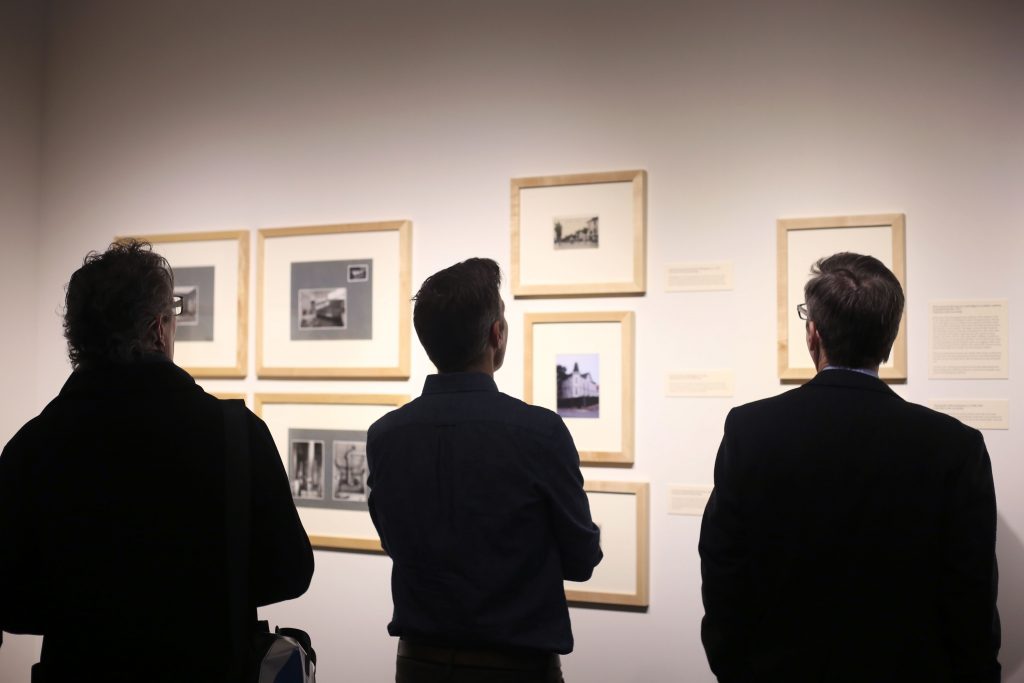
An exhibition unique to the museum, “The Binghamton Nuvolone: Restoring an Object in Six Parts” focuses on the life of Max Eisenstein, the previous owner of the eponymous piece. Eisenstein was an Austrian man who fled Vienna and came to Binghamton, bringing the painting and his family with him. The exhibition also focuses on the painting’s damaged condition, as three striking red lines divide the massive painting into six pieces.
The painting, gifted to the University’s gallery in 1982 by Norbert Eisenstein, Max Eisenstein’s son, is central to the exhibition, but the exhibition is organized into additional sections so people can explore other facets of the painting’s life. These include the science behind the painting and the methods used to conserve it, the biography of Max Eisenstein through personal letters and requests for restitution and the painting’s status as an artifact of World War II.
Though colloquially known as “The Binghamton Nuvolone,” the painting is of St. Benedict and was painted by Baroque painter Carlo Francesco Nuvolone during the 17th century. The painting’s history prior to Eisenstein’s ownership is unknown, although many people worked to investigate its provenance. However, the curators and researchers have made many inferences for the exhibition from the little knowledge they had of Eisenstein’s time. Eisenstein, a Jewish man living in Austria during the Third Reich, fled the country to escape persecution. It is assumed that the painting was cut by Eisenstein in six even pieces so that he could take it with him to Binghamton after fleeing Vienna.
“Yes, it is both a classic example of an old master painting, but perhaps primarily, it’s most valuable as an artifact of World War II and the Holocaust,” said Karen-edis Barzman, one of the curators of the installation and a professor of art history at BU. “We were trying to balance its status both as a master painting and an artifact of warfare.”
The painting’s mysterious destruction provokes questions that leave viewers asking why it was destroyed and why it was left in this condition. Barzman said her first reaction to the painting’s condition was shock.
“That’s the most striking part to me, to see a master painting mutilated like this,” she said. “My initial reaction when I first saw it in storage downstairs was, ‘Who would do such a thing to an old master painting?’”
The collaborative team of curators and directors, such as Diane Butler, director of the museum, Barzman and Neil Christian Pages, an associate professor of German studies and comparative literature at BU, contemplated restoring the work to what it would have looked like prior to its destruction. Although the exhibition features a digital replica of the painting showing its state before it was cut, the team decided to clean the painting instead of completely restoring it to its original form.
“We decided to leave the painting in this state because that’s the way it tells its story,” Barzman said. “It wants to tell us something about its social life as a painting and having something to do with the Holocaust.”
They were assisted by Joseph Tanski, professor of chemistry at Vassar College; Susan Blakney, a paintings conservator with West Lake Conservators; and faculty members from the geology and classics departments at BU.
The exhibition includes documents chronicling Eisenstein’s personal life after he fled Vienna, particularly through letters that discuss how the Holocaust affected him. In one letter from 1963, Eisenstein discusses “the catastrophe that befell [him] at the hands of the Nazis.” Eisenstein’s letters and personal memorabilia complement the painting and explain why it was not fully restored. The painting, and more specifically the damage to it, are representative of the Holocaust and how it affected the lives of those oppressed.
“When we started to unravel the history of the painting and the personal history of the owner, we realized it wasn’t an arbitrary act of mutilation, but it had something to do with preserving part of the family patrimony,” Barzman said.
The painting and its exhibition chronicle Binghamton’s own artistic history in addition to that of Eisenstein, as the painting was discovered in Eisenstein’s former home on Walnut Street on the West Side of Binghamton.
Annemarie Maag-Tanchak, a junior majoring in art history and president of the BU Fine Arts Society, said she admired how the exhibition focuses on something that is entrenched in Binghamton’s history.
“The Binghamton University Art Museum is right on campus and very accessible, and this exhibit in particular brings it close to home, and makes you see that there’s rich art and culture in Binghamton itself,” Maag-Tanchak said.
The exhibition also features a gathering of objects, photographs and papers paying homage to “Monuments Man” Kenneth C. Lindsay, the founder of Harpur College’s art history department and the museum. The exhibition will be open from March 15 to May 19 and will feature a free public symposium on May 3 from 4 p.m. to 7 p.m. to further discuss the painting’s history.


